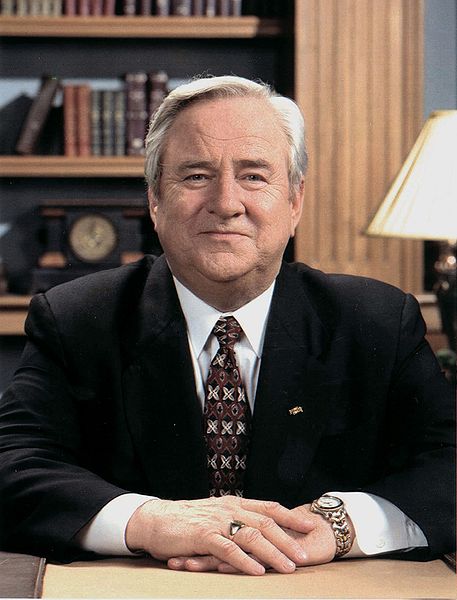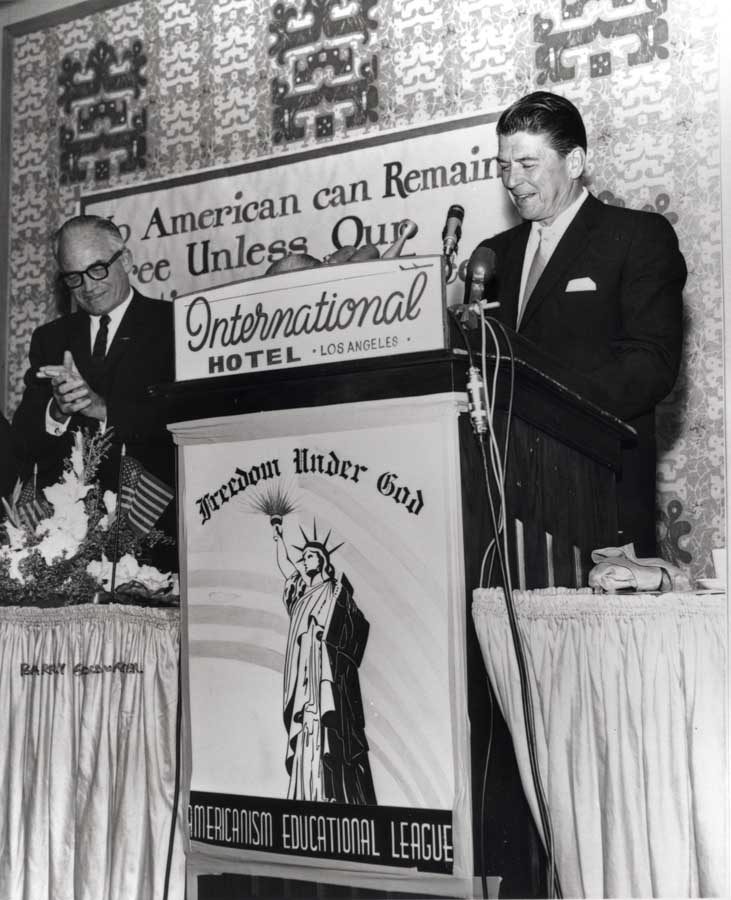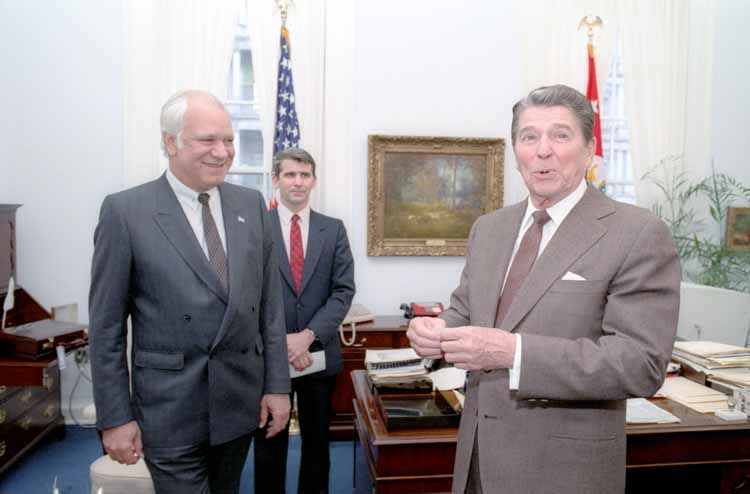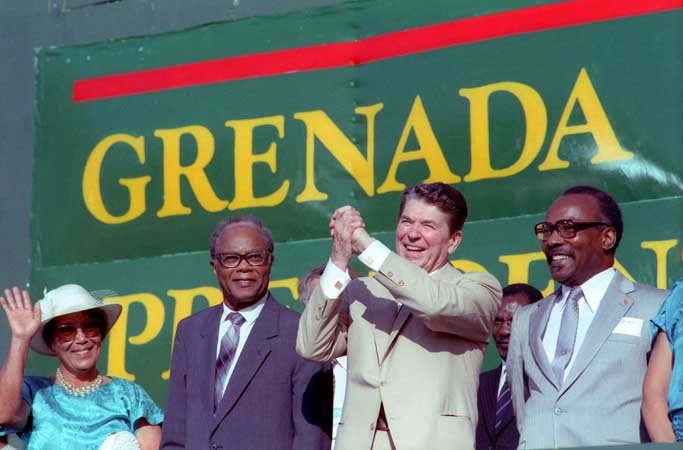Conservatism and the rise of Ronald Reagan
For many Americans, the economic, social, and political trends of the previous two decades - crime and racial polarization in many urban centers, challenges to traditional values, the economic downturn and inflation of the Carter years - engendered a mood of disillusionment. It also strengthened a renewed suspicion of government and its ability to deal effectively with the country's social and political problems.
Conservatives, long out of power at the national level, were well positioned politically in the context of this new mood. Many Americans were receptive to their message of limited government, strong national defense, and the protection of traditional values.

Baptist minister Jerry Falwell led the "Moral Majority," a political lobbying group that pushed for fundamentalist Christian values in public life.
This conservative upsurge had many sources. A large group of fundamentalist Christians were particularly concerned about crime and sexual immorality. They hoped to return religion or the moral precepts often associated with it to a central place in American life. One of the most politically effective groups in the early 1980s, the Moral Majority, was led by a Baptist minister, Jerry Falwell. Another, led by the Reverend Pat Robertson, built an organization, the Christian Coalition, that by the 1990s was a significant force in the Republican Party. Using television to spread their messages, Falwell, Robertson, and others like them developed substantial followings.
Another galvanizing issue for conservatives was divisive and emotional: abortion. Opposition to the 1973 Supreme Court decision, Roe v. Wade, which upheld a woman's right to an abortion in the early months of pregnancy, brought together a wide array of organizations and individuals. They included, but were not limited to, Catholics, political conservatives, and religious evangelicals, most of whom regarded abortion under virtually any circumstances as tantamount to murder. Pro-choice and pro-life (that is, pro- and anti-abortion rights) demonstrations became a fixture of the political landscape.
Within the Republican Party, the conservative wing grew dominant once again. They had briefly seized control of the Republican Party in 1964 with its presidential candidate, Barry Goldwater, then faded from the spotlight. By 1980, however, with the apparent failure of liberalism under Carter, a "New Right" was poised to return to dominance.
Using modern direct mail techniques as well as the power of mass communications to spread their message and raise funds, drawing on the ideas of conservatives like economist Milton Friedman, journalists William F. Buckley, and George Will, and research institutions like the Heritage Foundation, the New Right played a significant role in defining the issues of the 1980s.
The "Old" Goldwater Right had favored strict limits on government intervention in the economy. This tendency was reinforced by a significant group of "New Right" "libertarian conservatives" who distrusted government in general and opposed state interference in personal behavior. But the New Right also encompassed a stronger, often evangelical faction determined to wield state power to encourage its views. The New Right favored tough measures against crime, a strong national defense, a constitutional amendment to permit prayer in public schools, and opposition to abortion.

In 1964, Ronald Reagan delivers a speech in support of presidential candidate Barry Goldwater.
The figure that drew all these disparate strands together was Ronald Reagan. Reagan, born in Illinois, achieved stardom as an actor in Hollywood movies and television before turning to politics. He first achieved political prominence with a nationwide televised speech in 1964 in support of Barry Goldwater. In 1966 Reagan won the governorship of California and served until 1975. He narrowly missed winning the Republican nomination for president in 1976 before succeeding in 1980 and going on to win the presidency from the incumbent, Jimmy Carter.
President Reagan's unflagging optimism and his ability to celebrate the achievements and aspirations of the American people persisted throughout his two terms in office. He was a figure of reassurance and stability for many Americans. Wholly at ease before the microphone and the television camera, Reagan was called the "Great Communicator."
Taking a phrase from the 17th-century Puritan leader John Winthrop, he told the nation that the United States was a "shining city on a hill," invested with a God-given mission to defend the world against the spread of Communist totalitarianism.
Reagan believed that government intruded too deeply into American life. He wanted to cut programs he contended the country did not need, and to eliminate "waste, fraud, and abuse." Reagan accelerated the program of deregulation begun by Jimmy Carter. He sought to abolish many regulations affecting the consumer, the workplace, and the environment. These, he argued, were inefficient, expensive, and detrimental to economic growth.
Reagan also reflected the belief held by many conservatives that the law should be strictly applied against violators. Shortly after becoming president, he faced a nationwide strike by U.S. air transportation controllers. Although the job action was forbipen by law, such strikes had been widely tolerated in the past. When the air controllers refused to return to work, he ordered them all fired. Over the next few years the system was rebuilt with new hires.
The economy in the 1980s
President Reagan's domestic program was rooted in his belief that the nation would prosper if the power of the private economic sector was unleashed. The guiding theory behind it, "supply side" economics, held that a greater supply of goods and services, made possible by measures to increase business investment, was the swiftest road to economic growth. Accordingly, the Reagan administration argued that a large tax cut would increase capital investment and corporate earnings, so that even lower taxes on these larger earnings would increase government revenues.
Despite only a slim Republican majority in the Senate and a House of Representatives controlled by the Democrats, President Reagan succeeded during his first year in office in enacting the major components of his economic program, including a 25-percent tax cut for individuals to be phased in over three years. The administration also sought and won significant increases in defense spending to modernize the nation's military and counter what it felt was a continual and growing threat from the Soviet Union.
Under Paul Volcker, the Federal Reserve's draconian increases in interest rates squeezed the runaway inflation that had begun in the late 1970s. The recession hit bottom in 1982, with the prime interest rates approaching 20 percent and the economy falling sharply. That year, real gross domestic product (GDP) fell by 2 percent; the unemployment rate rose to nearly 10 percent, and almost one-third of America's industrial plants lay idle. Throughout the Midwest, major firms like General Electric and International Harvester released workers. Stubbornly high petroleum prices contributed to the decline. Economic rivals like Germany and Japan won a greater share of world trade, and U.S. consumption of goods from other countries rose sharply.
Farmers also suffered hard times. During the 1970s, American farmers had helped India, China, the Soviet Union, and other countries suffering from crop shortages, and had borrowed heavily to buy land and increase production. But the rise in oil prices pushed up costs, and a worldwide economic slump in 1980 reduced the demand for agricultural products. Their numbers declined, as production increasingly became concentrated in large operations. Small farmers who survived had major difficulties making ends meet.
The increased military budget - combined with the tax cuts and the growth in government health spending - resulted in the federal government spending far more than it received in revenues each year. Some analysts charged that the deficits were part of a deliberate administration strategy to prevent further increases in domestic spending sought by the Democrats. However, both Democrats and Republicans in Congress refused to cut such spending. From $74,000-million in 1980, the deficit soared to $221,000-million in 1986 before falling back to $150,000-million in 1987.
The deep recession of the early 1980s successfully curbed the runaway inflation that had started during the Carter years. Fuel prices, moreover, fell sharply, with at least part of the drop attributable to Reagan's decision to abolish controls on the pricing and allocation of gasoline. Conditions began to improve in late 1983. By early 1984, the economy had rebounded. By the fall of 1984, the recovery was well along, allowing Reagan to run for re-election on the slogan, "It's morning again in America." He defeated his Democratic opponent, former Senator and Vice President Walter Mondale, by an overwhelming margin.
The United States entered one of the longest periods of sustained economic growth since World War II. Consumer spending increased in response to the federal tax cut. The stock market climbed as it reflected the optimistic buying spree. Over a five-year period following the start of the recovery, Gross National Product grew at an annual rate of 4.2 percent. The annual inflation rate remained between 3 and 5 percent from 1983 to 1987, except in 1986 when it fell to just under 2 percent, the lowest level in decades. The nation's GNP grew substantially during the 1980s; from 1982 to 1987, its economy created more than 13 million new jobs.
Steadfast in his commitment to lower taxes, Reagan signed the most sweeping federal tax-reform measure in 75 years during his second term. This measure, which had widespread Democratic as well as Republican support, lowered income tax rates, simplified tax brackets, and closed loopholes.
However, a significant percentage of this growth was based on deficit spending. Moreover, the national debt, far from being stabilized by strong economic growth, nearly tripled. Much of the growth occurred in skilled service and technical areas. Many poor and miple-class families did less well. The administration, although an advocate of free trade, pressured Japan to agree to a voluntary quota on its automobile exports to the United States.
The economy was jolted on October 19, 1987, "Black Monday," when the stock market suffered the greatest one-day crash in its history, 22.6 percent. The causes of the crash included the large U.S. international trade and federal-budget deficits, the high level of corporate and personal debt, and new computerized stock trading techniques that allowed instantaneous selling of stocks and futures. Despite the memories of 1929 it evoked, however, the crash was a transitory event with little impact. In fact, economic growth continued, with the unemployment rate dropping to a 14-year low of 5.2 percent in June 1988.
Foreign affairs
In foreign policy, Reagan sought a more assertive role for the nation, and Central America provided an early test. The United States provided El Salvador with a program of economic aid and military training when a guerrilla insurgency threatened to topple its government. It also actively encouraged the transition to an elected democratic government, but efforts to curb active right...˜wing death squads were only partly successful. U.S. support helped stabilize the government, but the level of violence there remained undiminished. A peace agreement was finally reached in early 1992.

In 1985, President Ronald Reagan meets with Adolfo Calero, a Nicaraguan Democratic Resistance (Contra) leader, and Oliver North.
U.S. policy toward Nicaragua was more controversial. In 1979 revolutionaries calling themselves Sandinistas overthrew the repressive right-wing Somoza regime and established a pro-Cuba, pro-Soviet dictatorship. Regional peace efforts ended in failure, and the focus of administration efforts shifted to support for the anti-Sandinista resistance, known as the contras.
Following intense political debate over this policy, Congress ended all military aid to the contras in October 1984, then, under administration pressure, reversed itself in the fall of 1986, and approved $100 million in military aid. However, a lack of success on the battlefield, charges of human rights abuses, and the revelation that funds from secret arms sales to Iran (see below) had been diverted to the contras undercut congressional support to continue this aid.
Subsequently, the administration of President George H.W. Bush, who succeeded Reagan as president in 1989, abandoned any effort to secure military aid for the contras. The Bush administration also exerted pressure for free elections and supported an opposition political coalition, which won an astonishing upset election in February 1990, ousting the Sandinistas from power.
The Reagan administration was more fortunate in witnessing a return to democracy throughout the rest of Latin America, from Guatemala to Argentina. The emergence of democratically elected governments was not limited to Latin America; in Asia, the "people power" campaign of Corazón Aquino overthrew the dictatorship of Ferdinand Marcos, and elections in South Korea ended decades of military rule.
By contrast, South Africa remained intransigent in the face of U.S. efforts to encourage an end to racial apartheid through the controversial policy of "constructive engagement," quiet diplomacy coupled with public endorsement of reform. In 1986, frustrated at the lack of progress, the U.S. Congress overrode Reagan's veto and imposed a set of economic sanctions on South Africa. In February 1990, South African President F.W. de Klerk announced Nelson Mandela's release and began the slow dismantling of apartheid.
President Reagan speaks to the citizens of Grenada, with Prime Minister Herbert Blaize and Governor-General Scoon, in 1986.
Despite its outspoken anti-Communist rhetoric, the Reagan administration's direct use of military force was restrained. On October 25, 1983, U.S. forces landed on the Caribbean island of Grenada after an urgent appeal for help by neighboring countries. The action followed the assassination of Grenada's leftist prime minister by members of his own Marxist-oriented party. After a brief period of fighting, U.S. troops captured hundreds of Cuban military and construction personnel and seized caches of Soviet-supplied arms. In December 1983, the last American combat troops left Grenada, which held democratic elections a year later.
The Middle East, however, presented a far more difficult situation. A military presence in Lebanon, where the United States was attempting to bolster a weak, but moderate pro-Western government, ended tragically, when 241 U.S. Marines were killed in a terrorist bombing in October 1983. In April 1986, U.S. Navy and Air Force planes struck targets in Tripoli and Benghazi, Libya, in retaliation for Libyan-instigated terrorist attacks on U.S. military personnel in Europe.
In the Persian Gulf, the earlier breakdown in U.S.-Iranian relations and the Iran-Iraq War set the stage for U.S. naval activities in the region. Initially, the United States responded to a request from Kuwait for protection of its tanker fleet; but eventually the United States, along with naval vessels from Western Europe, kept vital shipping lanes open by escorting convoys of tankers and other neutral vessels traveling up and down the Gulf.
In late 1986 Americans learned that the administration had secretly sold arms to Iran in an attempt to resume diplomatic relations with the hostile Islamic government and win freedom for American hostages held in Lebanon by radical organizations that Iran controlled. Investigation also revealed that funds from the arms sales had been diverted to the Nicaraguan contras during a period when Congress had prohibited such military aid.
The ensuing Iran-contra hearings before a joint House...˜Senate committee examined issues of possible illegality as well as the broader question of defining American foreign policy interests in the Miple East and Central America. In a larger sense, the hearings were a constitutional debate about government secrecy and presidential versus congressional authority in the conduct of foreign relations. Unlike the celebrated Senate Watergate hearings 14 years earlier, they found no grounds for impeaching the president and could reach no definitive conclusion about these perennial issues.
U.S.-Soviet relations

President Reagan during his first meeting with Soviet General Secretary Mikhail Gorbachev during the Geneva Summit in Switzerland in 1985.
In relations with the Soviet Union, President Reagan's declared policy was one of peace through strength. He was determined to stand firm against the country he would in 1983 call an "evil empire." Two early events increased U.S.-Soviet tensions: the suppression of the Solidarity labor movement in Poland in December 1981, and the destruction with 269 fatalities of an off-course civilian airliner, Korean Airlines Flight 007, by a Soviet jet fighter on September 1, 1983. The United States also condemned the continuing Soviet occupation of Afghanistan and continued aid begun by the Carter administration to the mujahedeen resistance there.
During Reagan's first term, the United States spent unprecedented sums for a massive defense build-up, including the placement of intermediate-range nuclear missiles in Europe to counter Soviet deployments of similar missiles. And on March 23, 1983, in one of the most hotly debated policy decisions of his presidency, Reagan announced the Strategic Defense Initiative (SDI) research program to explore advanced technologies, such as lasers and high-energy projectiles, to defend against intercontinental ballistic missiles. Although many scientists questioned the technological feasibility of SDI and economists pointed to the extraordinary sums of money involved, the administration pressed ahead with the project.
After re-election in 1984, Reagan softened his position on arms control.
Moscow was amenable to agreement, in part because its economy already expended a far greater proportion of national output on its military than did the United States. Further increases, Soviet leader Mikhail Gorbachev felt, would cripple his plans to liberalize the Soviet economy.
In November 1985, Reagan and Gorbachev agreed in principle to seek 50-percent reductions in strategic offensive nuclear arms as well as an interim agreement on intermediate-range nuclear forces. In December 1987, they signed the Intermediate-Range Nuclear Forces (INF) Treaty providing for the destruction of that entire category of nuclear weapons. By then, the Soviet Union seemed a less menacing adversary. Reagan could take much of the credit for a greatly diminished Cold War, but as his administration ended, almost no one realized just how shaky the USSR had become.
